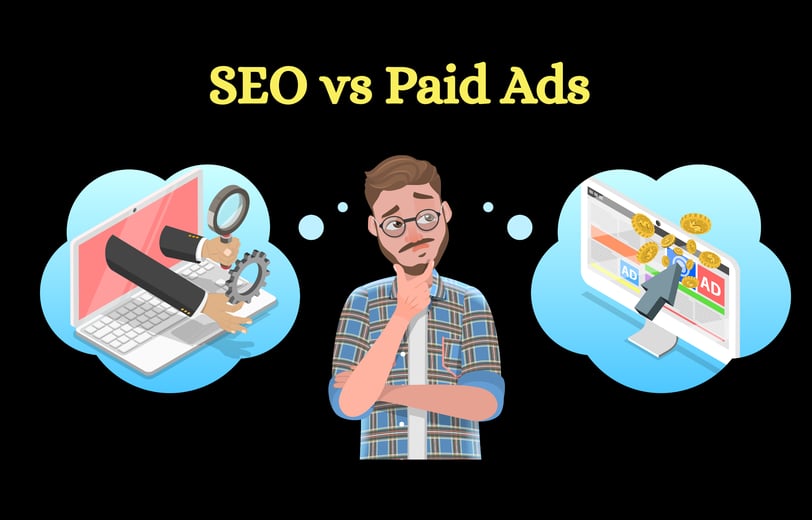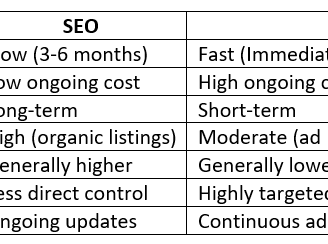SEO or Paid Ads? Which is the Right Investment for Business Growth in 2025
Discover the key differences between SEO and Paid Ads in this in-depth guide tailored for startups and small business owners. Learn which strategy offers better ROI, when to use each, and how to build a smart marketing mix that drives real growth.
SEO 2025
Lekha
4/30/20255 min read


Startups and business owners often struggle to figure out where to invest their marketing budget. Every dollar counts, and making the right decision between Search Engine Optimization (SEO) and Paid Advertising can significantly affect visibility, customer acquisition, and overall ROI. Dynamics in 2025 have changed drastically in terms of how people behave online or how Google is ranking content on the search engine. Only to survive, let alone trying to stay ahead in the race, it's very crucial to stay updated regarding these changes.
In this blog, we have tried to simplify it for you the pros and cons of SEO and Paid Ads, and help you decide which is the better investment for your business, based on your goals, available resources, and stage of growth.
Understanding the Basics
What is SEO (Search Engine Optimization)?
SEO, or Search Engine Optimization in layman terms is the process of optimizing your website and content to rank higher in organic search engine results. The ultimate goal is to increase visibility and drive more unpaid (or "organic") traffic from search engines like Google.
Key Components of SEO Includes:
On-page SEO: Optimizing content, meta tags, images, and keywords.
Technical SEO: Enhancing site speed, mobile-friendliness, and crawlability.
Off-page SEO: Building high-quality backlinks, brand mentions, and domain authority.
What are Paid Ads?
Paid advertising, often referred to as Pay-Per-Click (PPC), involves placing ads on search engines (like Google Ads), social media platforms, or third-party websites. You pay each time someone clicks on your ad.
Some popular ones are:
Search ads (Google Ads, Bing Ads)
Display ads (banners, sidebars)
Social media ads (Facebook, Instagram, LinkedIn)
Retargeting ads
The Pros and Cons: SEO vs Paid Ads
SEO: The Long-Term Growth Strategy
Pros:
Cost-Effective Over Time: Initially, one may have to spend a lot on SEO, but once your SEO efforts start gaining traction, you can enjoy consistent traffic without an ongoing ad spend.
Credibility and Trust: Organic rankings are often perceived as more credible by users. Google also place its trust more on organic traffic.
Sustainable Results: High-quality SEO builds authority and can maintain rankings with less effort over time.
Increased Click-Through Rate (CTR): Users tend to click more on organic listings than paid ads.
Cons:
Takes Time: SEO is a slow process; one can’t expect to rise on rankings overnight. It may take 3-6 months (or longer) to see significant results.
Algorithm Dependency: Search engine algorithms change frequently; efforts are always needed to keep up.
Requires Ongoing Effort: One has to be very consistent- regular content updates, link-building, and technical audits are necessary.
Paid Ads: The Instant Visibility Tool
Pros:
Immediate Results: You don’t have to wait for months for your website to appear on the first page of search results; this can happen within hours of launching an ad campaign.
Highly Targeted: Paid ads can be highly-focused based on demographics, behaviour, location, and interests.
Measurable ROI: One can track every click, conversion, and dollar spent in real time.
Brand Visibility: A great investment for new product launches or events, to gain higher brand visibility.
Cons:
Costly: Especially in competitive industries, Cost-Per-Click (CPC) can be extremely high.
Short-Lived: You can’t rely on the results for long run. Once you stop paying, the traffic stops.
Ad Fatigue: Users can become blind to ads, reducing effectiveness over time.
Click Fraud: There's always a risk of competitors or bots clicking your ads to waste your budget.
SEO vs Paid Ads: A Comparative Breakdown
Understanding with the Help of Case Studies
Case Study 1: Startup Launching a New Product- Paid Ads First, SEO Second
LumiWear Smart Apparel
LumiWear, a wearable tech startup, launched a line of LED-embedded fitness apparel. Their primary goal was to create a buzz around and generate immediate sales.
Strategy:
Invested $4,000/month in Instagram and Google search ads targeting fitness enthusiasts and tech-savvy buyers.
Ran influencer campaigns and repurposing ads for product retargeting.
Simultaneously built a blog targeting keywords like "best tech workout gear" and "wearable fitness fashion."
Results:
Achieved 8,000 unique visitors in the first 30 days.
Generated 550+ email leads and $12,000 in sales.
Within 4 months, SEO traffic began converting at 4.8%, reducing ad spend to $1,000/month while retaining revenue.
Takeaway: Paid ads were crucial for short-term traffic, while SEO laid the foundation for sustainable growth.
Case Study 2: A Local Business With Limited Budget — Local SEO as a Game Changer
GreenLeaf Landscaping
GreenLeaf, a small landscaping business in Austin, Texas, had a minimal marketing budget but wanted more local visibility.
Strategy:
Optimized Google Business Profile with high-quality photos and customer reviews.
Listed in local directories like Yelp and HomeAdvisor.
Created location-based content, e.g., “Best Landscaping Services in Austin.”
Results:
Gained 40% increase in inbound calls within 60 days.
Ranked in Google’s Local Pack for key phrases like “landscapers near me.”
Spent $0 on ads and continued to grow via referrals and reviews.
Takeaway: For small service-based businesses, local SEO delivers consistent value with minimal investment.
Case Study 3: An E-commerce Store — Dual Approach for Maximum ROI
PurePet Organics
PurePet Organics sells natural supplements for dogs and cats. As a DTC e-commerce brand, they needed both reach and trust.
Strategy:
Ran Google Shopping and Facebook carousel ads targeting pet owners.
Developed SEO-rich product descriptions and informative blog posts, like; “How to Boost Your Dog’s Immunity Naturally”.
Created landing pages optimized for long-tail keywords.
Results:
7x ROAS (Return on Ad Spend) on pet wellness campaigns.
Organic traffic grew 120% in 6 months.
SEO blog posts brought 25% of total traffic by month 5, reducing reliance on paid ads.
Takeaway: A blended strategy helped reduce CAC (Customer Acquisition Cost) and build brand loyalty.
Case study 4: A B2B Company Looking for Long-Term Leads — Content-Driven SEO with Supplementary Ads
SaaSFlow CRM
SaaSFlow, a B2B SaaS startup offering a CRM tool, had a high-value product with a longer sales cycle.
Strategy:
Created SEO-optimized thought leadership content like whitepapers and case studies.
Published weekly blog posts around keywords like “best CRM for small businesses” and “automated sales funnels.”
Ran LinkedIn lead gen ads targeting decision-makers in small to mid-sized companies.
Results
SEO drove 60% of inbound leads by month 6.
Cost-per-lead from paid ads was high initially but decreased by 35% due to better targeting.
3 whitepapers generated 1,200+ qualified leads through gated content.
Takeaway: SEO brought long-term authority while paid ads jumpstarted B2B lead generation.
How to Choose the Right Strategy: Ask the Right Question
What’s your marketing budget? If you have a limited budget, SEO offers more sustainable returns over time.
Do I need quick results? Something that can generate leads tomorrow? Go with Paid Ads.
Are you building a long-term trust-based brand? SEO is essential for organic authority and visibility.
What internal resources do you have? SEO requires content creation, link building, and technical optimization.
Are you in a highly competitive industry? You may need both to break through the noise.
The Best Approach: It’s About the Right Mix for Your Business
Here’s the truth—it’s not SEO or Paid Ads. The best-performing businesses often use a combination of both. In a competitive market, strategies don’t work in isolation, the correct ratio is the recipe of success.
If you’re a startup aiming for rapid growth, Paid Ads can help you sprint. If you’re building a long-lasting brand, SEO is your endurance plan. But together, they’re a powerhouse.
Why?
SEO builds the foundation. It increases organic visibility and trust.
Paid Ads amplify reach. They bring in immediate traffic and fill the gaps.
Recommended Strategy: Use Paid Ads to drive traffic while it buys time for SEO to gain traction. Over time, scale down ad spend and rely more on your organic growth.
Thanks for visiting my blog! If you find the content useful please subscribe to my newsletter for more such valuable content.


Know more about us
Your go-to for unique content solutions.
Services
© 2025. All rights reserved.
QUICK LINKS
View our Privacy Policy and Terms & Conditions.
